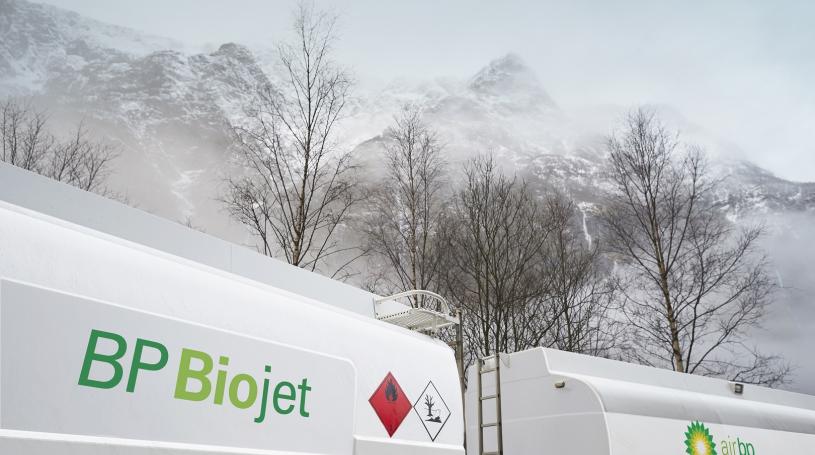Can aviation ever be truly green?
As the aviation division of BP, Air BP is one of the world’s leading suppliers of aviation fuel products and services. The following article, by Air BP Low Carbon, Commercial Development Manager Tom Parson, explores some of the trends and future of sustainable aviation fuel.
There’s no denying that air travel has changed the way the world works, but our ability to fly pretty much wherever and whenever we like comes at an environmental cost, with aviation accounting for around 2 per cent of global greenhouse gas emissions today. The sector is taking action though; in the UK, for example, the aviation industry has pledged to cut its net carbon emissions to zero by 2050. But, how might such goals be met?
Cleaner fuels
Sustainable Aviation Fuel (SAF) produced from renewable feedstocks including wastes such as used cooking oil and household rubbish is currently the most viable route to reducing CO2 emissions in air transport. It has been designed as a ‘drop-in’ fuel and can be blended with up to 50% traditional jet fuel so that it is safe to use in existing aircraft and airport infrastructure.
Air BP has already taken significant steps to help shape a lower carbon aviation industry; in recent years we’ve supplied SAF to 16 locations in six countries. What’s more, in 2018 we agreed a collaboration with leading fuel producer Neste to develop and supply SAF from non-palm renewable and sustainable raw materials, including used cooking oil. These fuels can reduce the carbon footprint of aviation fuel by up to 80% over their full life cycle.
So, why isn’t SAF more widely available? Currently SAF costs significantly more than traditional aviation fuel, so the big challenge with bringing it to market involves managing cost. However, we expect that cost to come down as feedstock becomes more widely available and more efficient production technologies are developed.
Efficient aircraft
Engine design has also changed massively over the past decade or so. Manufacturers are constantly innovating with more efficient aircraft. As a result, we are already seeing engines that are lighter and more powerful which mean they burn less fuel. For example, the A350 from Airbus has lowered CO2 emissions by approximately 25% per seat compared to previous generation competitor aircraft.*
* Source Airbus: www.airbus.com/aircraft/passenger-aircraft/a350xwb-family.html
The electrification of aircraft is another exciting space that the industry is still in the early stages of development for battery-powered planes. We are a few decades off seeing large-scale commercial electric passenger jets taking to the sky. But the electric revolution was certainly making its mark at last year’s Paris Air Show, where we saw the unveiling of several prototypes for electric aircraft models capable of seating up to 10 passengers. These are ideal for the general aviation market.
The UK government has announced a grant of £2.7m to Zeroavia, a California start-up that is developing a hydrogen-powered six-seater light aircraft to operate at distances of up to 350 miles. This plane is due to take to the skies over the UK in little over a year. This is an example of how hydrogen is a potential long-term solution for shorter flights, but still requires significant development. All these initiatives are yet to be scalable, but they do show what might be possible.
Carbon offsetting
It’s been a decade since the aviation industry set ambitious CO2 targets, including carbon-neutral growth from 2020. And as an industry we’re on target to meet that, initially at least, through carbon offsetting.
Across our international network of more than 250 carbon neutral Air BP operated facilities, the primary aim is to drive efficiency in technologies such as start/ stop solutions on vehicles, improve operational efficiency of waste and stock management, maximise options for supplying SAF among other initiatives. Then any residual emissions, following these reductions, are offset through BP Target Neutral – a programme that enables us to offset emissions by purchasing carbon credits from carefully-selected environmental projects around the world. As far as we are aware, we are extremely proud to be the first fuel supplier to achieve carbon neutrality for into-plane fuelling services across our international operations.
Beyond aviation
BP is also looking beyond the aviation sector to support and develop new lower carbon businesses. In 2017 BP joined forces with a trailblazing British company called Lightsource – Europe’s largest solar developer. The goal was to help fund the worldwide growth of the UK-based business. Two years on and Lightsource BP has more than doubled its footprint around the world.
As the world turns its attention to tackling the climate challenge and reducing carbon emissions, air travel is likely to come under increased scrutiny. It’s clear there is a real focus and commitment within the aviation industry to achieve a more sustainable future.
Further enquiries:
Emerald Media, +44 1420 560094, liz.danner@emeraldmedia.co.uk
Notes to editors
As the aviation division of BP, Air BP is one of the world’s leading suppliers of aviation fuel products and services. We have been investing in the aviation industry for over 90 years to keep people flying safely around the world. We supply around 6.6 billion gallons of aviation fuel a year; fuelling over 6,000 flights a day at over 800 locations in more than 55 countries – that’s more than four planes a minute.
Our customers include commercial airlines, the military, business and private aircraft owners, airports and airfield operators. We have a wide range of services to support our fuel offer including the design, build and operation of fuelling facilities, technical consultancy and training, low carbon solutions, the Sterling Card for efficient general aviation refuelling and innovative digital platforms to increase efficiency and reduce risk.
For more information, go to www.airbp.com
– ENDS –
In order to utilize the ‘safe harbor’ provisions of the United States Private Securities Litigation Reform Act of 1995 (the ‘PSLRA’), BP is providing the following cautionary statement. This press release contains certain forward-looking statements – that is, statements related to future, not past events and circumstances – which may relate to one or more of the financial condition, results of operations and businesses of BP and certain of the plans and objectives of BP with respect to these items. These statements are generally, but not always, identified by the use of words such as ‘will’, ‘expects’, ‘is expected to’, ‘aims’, ‘should’, ‘may’, ‘objective’, ‘is likely to’, ‘intends’, ‘believes’, ‘anticipates’, ‘plans’, ‘we see’ or similar expressions. Actual results may differ from those expressed in such statements, depending on a variety of factors including the risk factors set forth in our most recent Annual Report and Form 20-F under “Risk factors” and in any of our more recent public reports.
Our most recent Annual Report and Form 20-F and other period filings are available on our website at www.bp.com, or can be obtained from the SEC by calling 1-800-SEC-0330 or on its website at www.sec.gov.

